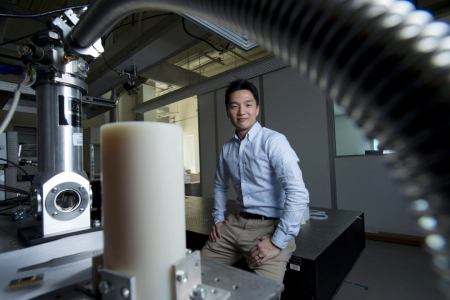UCI Engineer Creates New Technique for Testing Nanomaterials

Ultimate goal of research is to turn waste heat into electricity.
July 13, 2016 — A University of California, Irvine engineer has invented a method for analyzing nanowires at temperatures approaching 800 degrees Fahrenheit in first-ever experiments, showing the valuable role the materials could play in converting excess heat from machines and electronics into useable electricity.
“Auto manufacturers and tech startups are trying to utilize and commercialize heat-to-electricity applications, but first they need highly efficient building blocks to make that happen,” said Jaeho Lee, UCI assistant professor of mechanical & aerospace engineering and lead author of a study in the current issue of Nano Letters. “Our work verifies what engineers have long expected: that certain materials would have good thermoelectric properties at the nanometer scale even at high temperatures.”
He and his colleagues were able to achieve this result through the clever customization of a commercially available vacuum chamber and related equipment. Just off the shelf and throttled up to intense heat for other experiments, the apparatus would melt wire coatings and destroy the adhesives used to fuse nanowire chips to their holders.
The team alleviated these problems by employing heat-tolerant wiring and screws instead of glues to hold pieces in place. They also created a unique sample mounting platform that minimizes heat loss and lets researchers control the nanowires’ temperature with high precision.
One of the fundamental goals of Lee’s area of research is decoupling electrical conductivity and temperature to produce energy from waste heat, and his work at UCI is demonstrating that silicon nanowires may be the right materials for the job.
The findings of the study, conducted when Lee was a postdoctoral scholar at Lawrence Berkeley National Laboratory, also pave the way for other extreme-heat experiments, according to UCI materials scientist Allon Hochbaum, who was not involved in the research.
“Jaeho’s new work develops the ability to measure the thermal conductivity of nanoscale materials at higher temperatures than was previously possible,” he said. “This allows for the characterization of promising high-temperature thermoelectric substances, such as silicon nanowires, under conditions similar to their optimal operating temperature.”
In their quest to recycle waste heat, engineers are seeking elements that permit the smooth flow of electricity while resisting heat. In bulk, silicon is a good transmitter of both electricity and warmth. But scientists have long witnessed a sharp decrease in thermal conductivity when dealing with silicon at the micro- and nanometer scales.
“Heat scatters with the surface boundaries, so when you make a nanowire, the thermal conductivity could be as low as two orders of magnitude less than the thermal conductivity of the bulk material,” Lee said.
- Brian Bell / UCI
